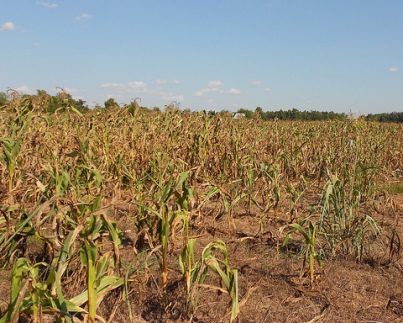A private GMO corn study reveals that high yield “breeding” is messing up the crop’s ability to adapt to environmental stress and change. Not surprising. They use a very limited gene pool suited to the desired result; ever-increasing yields. However, as many a farmer and gardener knows, there’s a limit to what is possible with plants. Before you even start tampering with their genetic structure and splicing in foreign entities like bacteria and pesticides.
 Common sense tells you this will cause an imbalance, much like the chemistry of the human body being out of whack. We all know that leads to a wide array of health and vigor issues. And plants, both GMO and normal, really aren’t all that different. Just look at what happens when your garden has a nutrient imbalance. And while Big Seed has a chemical band-aid for much that can interrupt mega yield monocropping… they have yet to discover an instant chemical fix for environmental instability.
Common sense tells you this will cause an imbalance, much like the chemistry of the human body being out of whack. We all know that leads to a wide array of health and vigor issues. And plants, both GMO and normal, really aren’t all that different. Just look at what happens when your garden has a nutrient imbalance. And while Big Seed has a chemical band-aid for much that can interrupt mega yield monocropping… they have yet to discover an instant chemical fix for environmental instability.
Worrying about that is just too costly. Profit and faster GMO product release remain king:
“The alternative of selecting first for adaptability and second for optimal performance is not economically practical: one cannot test everything, everywhere.”
– Bob Benson, Syngenta Seeds
I found that in the comments on the LinkedIn Pulse post introducing this long-term private, publicly-funded study’s findings. Noncommercial GMO corn research? A-maize-ing, isn’t it? And it’s been ongoing for years. Beginning in 2014, ag universities in 20 states and Ontario in various growing zones have tested over 2400 “modern” (a.k.a. GMO) corn varieties on tens of thousands of plots.
These academic scientists monitored and recorded everything vital from each plot’s soil structure, nutrient availability, and the weather. Constantly. Environmental readings, taken every 30 minutes, covered the things plants require for performance:
- Air Temperature
- Humidity
- Solar radiation
- Rainfall
- Wind speed
- Wind direction
- Soil temperature
- Soil moisture
So, yes Bob, you can test everything, everywhere. In fact, were the true purpose of GMO crops actually feeding the world, economic feasibility of ensuring such seems a no-brainer. What does it matter how much the corn crop yields if it cannot adapt to weather change stress? The weather changes constantly, in every location. El Niño and La Niña take us from one extreme to another. And lately, it’s prone to more ridiculous swings than ever.

The economically feasible approach to commercial GMO seed development is coming up with a handful of products for growing in huge areas. They’re swiftly designed, briefly tested, and marketed based on the best trial results. The problem with that?
“When you try to adapt cultivars to many different environments, you end up with plants that are not great anywhere. The cost of maintaining this plasticity is at the detriment of maximum productivity.”
– Dr. Natalia de Leon, agronomy professor at University of Wisconsin and Genomes To Fields collaborator
By monitoring the actual plants’ responses, dozens of scientists found that high yield corn cannot adapt to environmental stress as well as its predecessors. The proof is in the numbers. Ridiculously high yield GMO corn plants only excel if the growing environment equals the trials it excelled in.
And what they’ve learned from the data gathered over the past 3 years is important to farmers and consumers. The Genomes to Fields initiative finds that GMO corn breeding needs to incorporate better climate adaptability. Starting with broadening the gene pool. Whatsmore, it’s not just corn.
“Releasing varieties without pests and disease tolerances and adaptability through GxE understanding not only affects the productivity of farms, but also builds up populations of pests and diseases in those environments. Focusing just on yield may give good results in on site trials, but it will not translate to on farm productivity.”
– Shoba Venkatanagappa, Rice Research Institute
In treating plants like machines, industrial agriculture forgets that plant diversity existed for a reason. Take landrace grains, for example, corn or wheat can adapt to many environments. It’s not an overnight miracle, but by the third year, planting saved seed delivers an abundant harvest. The secret is the saved seed produces plants already adapted to the microclimate the parent plant grew in. In fact, saving seed from the open-pollinated tomatoes, green beans, squash, etc. from your garden gives you crops more adapted to your local environment than buying new seed.

But saved seeds are the problem. We can’t have that. Commercial hybrid and GMO seed cannot be saved. In the case of licensed GMOs, this ensures mountains of new seed sales each spring, followed by boatloads of support pesticides and fertilizers.
What a wonderful world we live in. So modern. So accomplished. Yet, so many still go hungry while many others subsist on a largely synthetic diet. All despite the super-sized GMO corn harvest. And just think, about a generation ago a family could eat well and generate a living income with a really small farm growing a variety of crops and livestock. Some years were good, some were bad, and if they were poor, they often didn’t know they were.
Learn more:
- Breeding Maize for High Productivity Appears to Limit Adaptability
- Genomes To Fields Initiative
- What is GxE Understanding?
Images courtesy of Fishhawk, and Crane-Station (respectively).
[/et_pb_text][/et_pb_column][/et_pb_row][/et_pb_section]